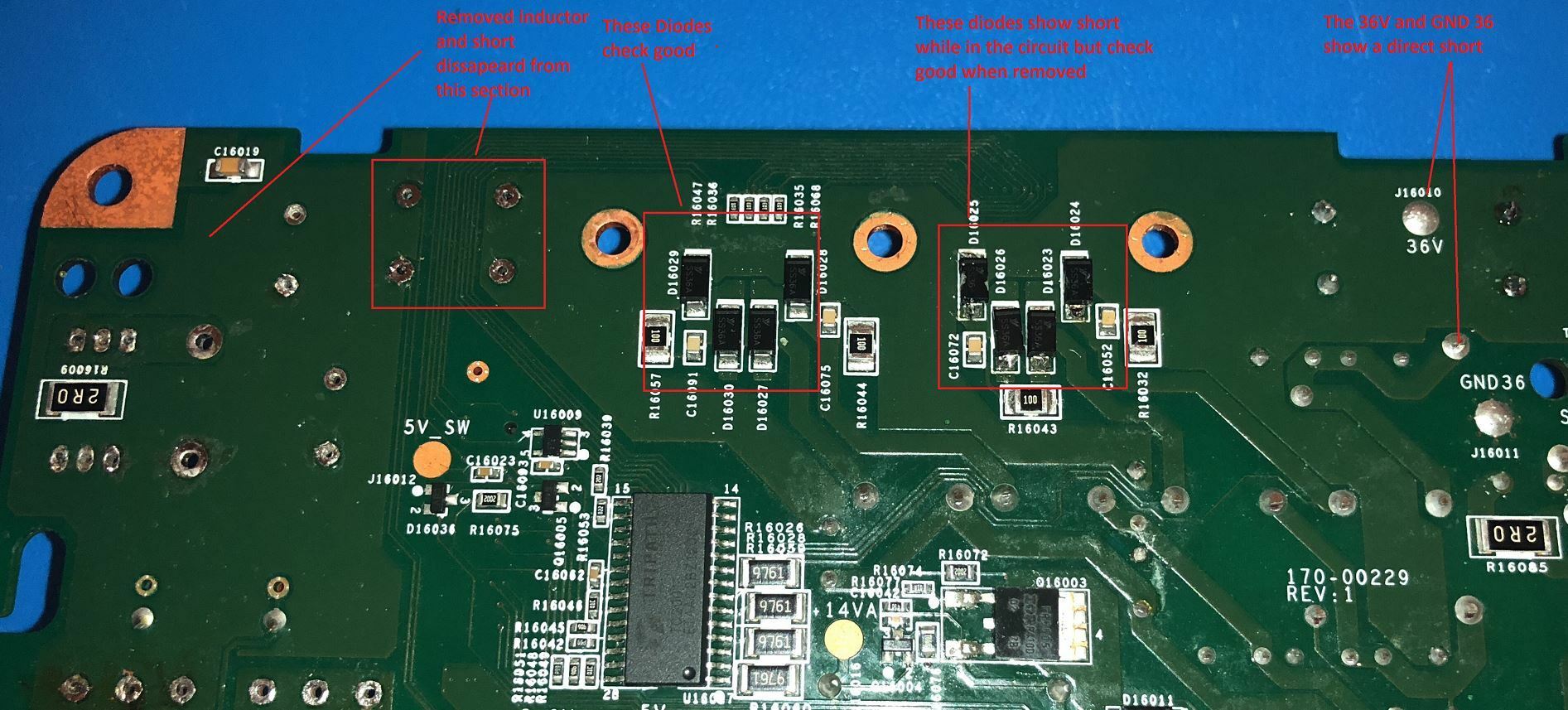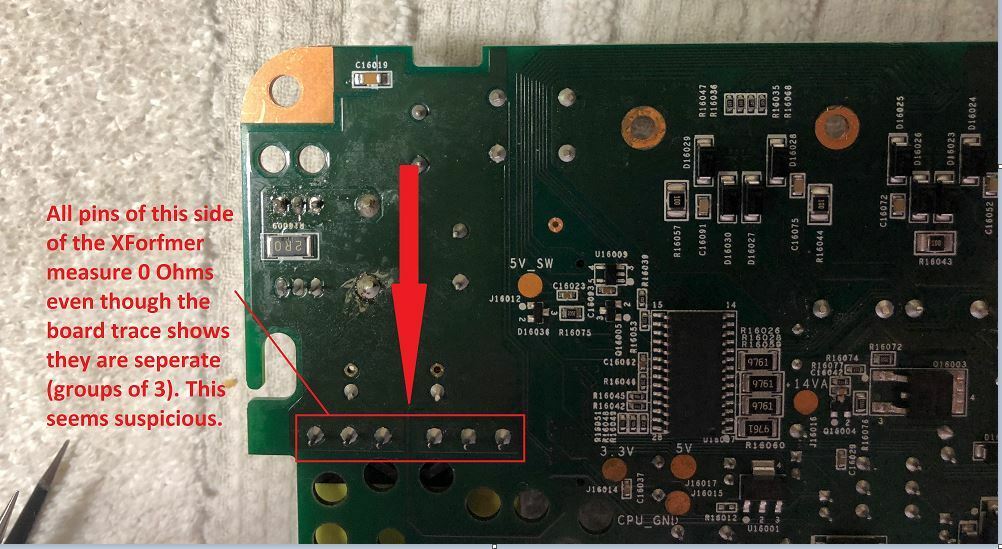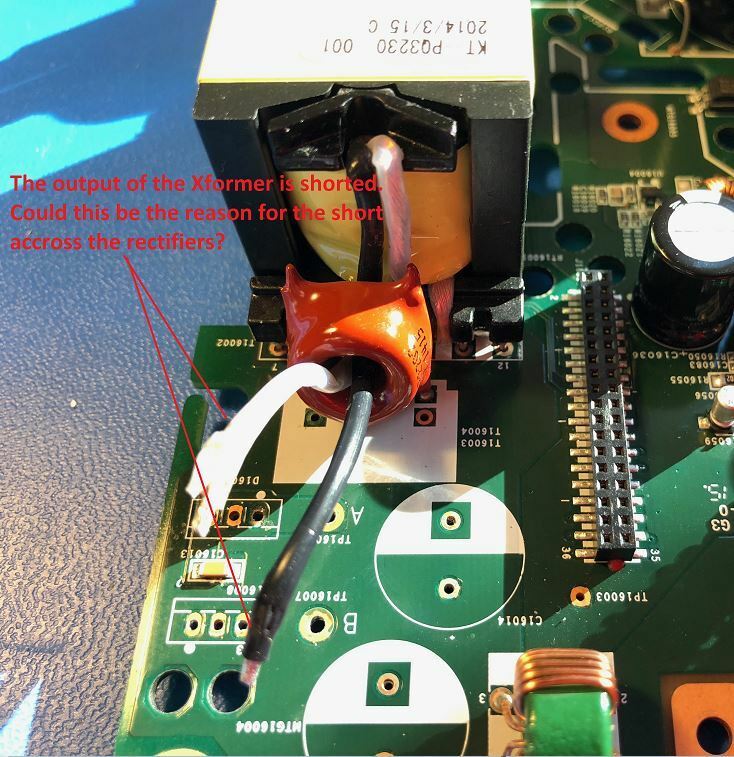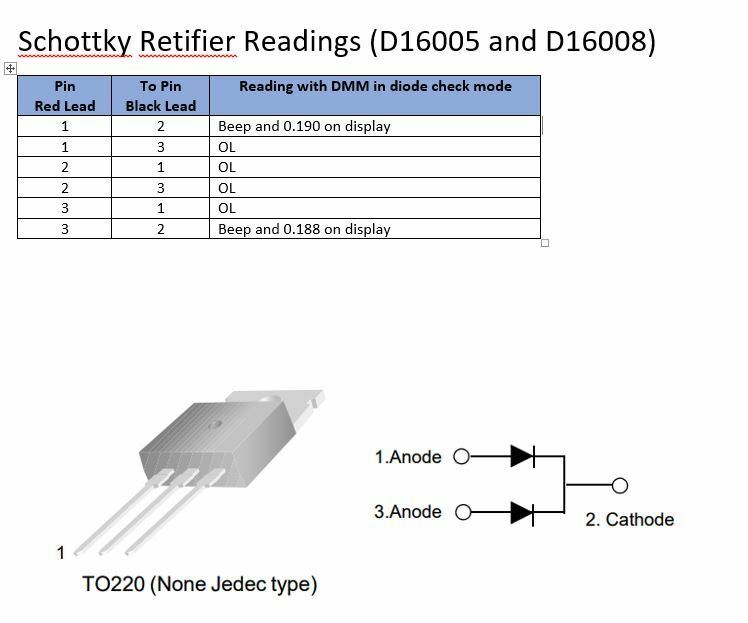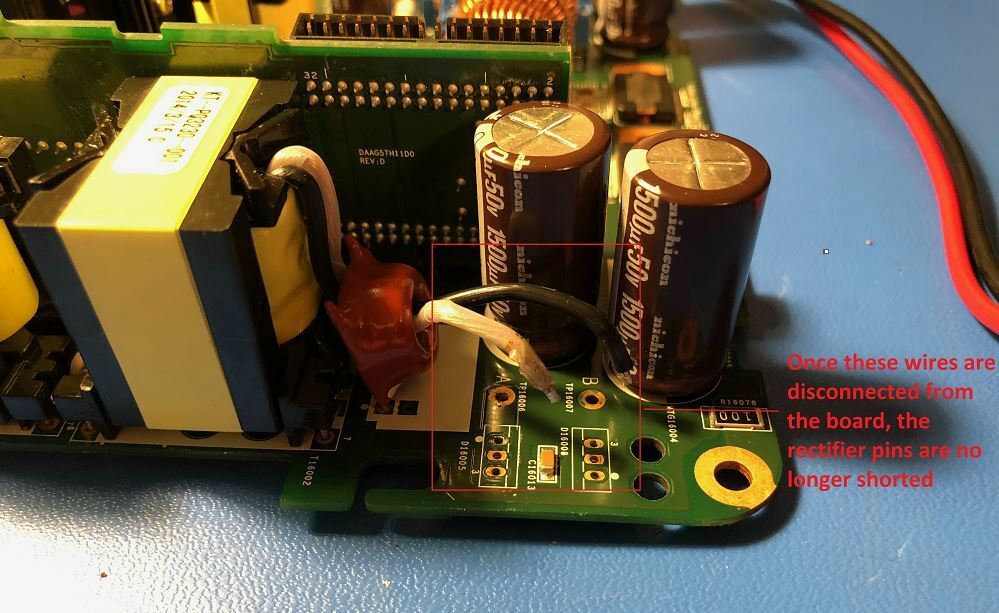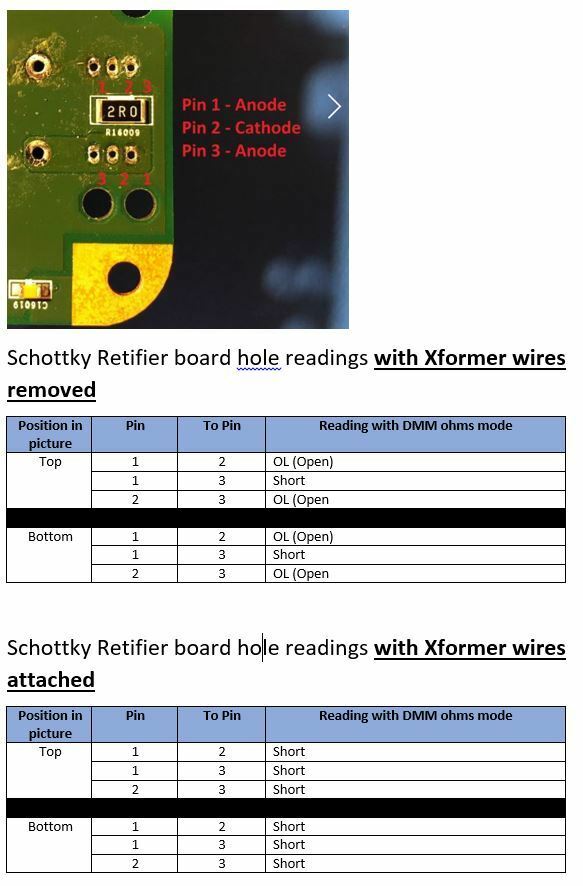The amp has no power. Is there an internal fuse for this unit?
Has anyone taken one apart?
Page 12 / 17
Yes, the inductors may appear to as shorts if they are used with dual windings for filtering... same concept as the transformer. Also, chances are that your transformers and inductors are ok. Those are really really hard to blow. Concentrate on diodes/caps/resistors/ICs.
Small tip: If your components look good... put them back in. Its easy to lose the correct ones. If you want to leave off inductors and transformers, then thats fine.
Second small tip: Test what you can on-board/in-circuit. If it looks good, you can likely not worry about removing it. If it looks bad, then you can do a secondary test after removing it. That may prevent having to remove a lot.
Small tip: If your components look good... put them back in. Its easy to lose the correct ones. If you want to leave off inductors and transformers, then thats fine.
Second small tip: Test what you can on-board/in-circuit. If it looks good, you can likely not worry about removing it. If it looks bad, then you can do a secondary test after removing it. That may prevent having to remove a lot.
Also there doesn’t seem to be anything visually to indicate component failure such a as burns or broken areas
No I haven’t plugged the board in since I have a bunch of components removed. I have been visually inspecting and checking with my meter however it is hard to see where the short is right now as there are a lot of components in that area. Also a lot of inductors.
Keep going 😉 You are getting there...
Have you felt any of the components getting warm? A short will typically be very warm somewhere and that will likely be the culprit.
Have you felt any of the components getting warm? A short will typically be very warm somewhere and that will likely be the culprit.
OK so I made a little more progress today. I removed the transformer and checked it out of the circuit. It checks out OK. I them removed the inductor near where I removed the caps and found that the short disappeared from that part of the circuit. I then started to look at the diodes that are in the picture below. The first set checked out OK while in the circuit but the second set shows a short. I then removed the diodes and checked them out of the circuit and they check out OK. So something else in that part of the circuit is shorted. Also the 36V and GND 36 test points show shorted.
Yep... the 3 in each set should be shorted since they are on the same winding (with a tap) and the 2 sets of 3 should certainly not be shorted as those are different windings. Sounds like you are getting close. 🙂. Yes... now is the time to start removing components to hunt down the short. You can do some of that on board like diodes and resistors... but not always. Look for shorts across components and if so, they are suspect for removal.
Thanks for the info m0untainman. I think I found a major issue as that 36V power supply circuit definitely has a short. I asked gruv2ths in a PM to measure the 2 sets of pins on that transformer in my pics above and he is showing that all 3 in each set are shorted together but the sets are NOT shorted to each other. This is where my issue is. My transformer readings show a short between the sets (0 Ohms). This means that something in that circuit is shorted which is I am assuming causing no output from the 36V supply.
I have visually inspected the entire board multiple times and cannot see any evidence that would indicate shorted components, so I think I now have to start removing components to check for shorts.
I have visually inspected the entire board multiple times and cannot see any evidence that would indicate shorted components, so I think I now have to start removing components to check for shorts.
This should also explain why you will see a short on your rectifiers while in circuit:
https://sub.allaboutcircuits.com/images/quiz/02311x01.png
So its normal.
https://sub.allaboutcircuits.com/images/quiz/02311x01.png
So its normal.
Good info ando1. The 2 wires will appear to short because its a winding. They should short as that's how a transformer works. See this to understand why:
https://en.wikipedia.org/wiki/Transformer#/media/File:Transformer3d_col3.svg
You should see a little bit of resistance on it (a few ohms?), but very small. If it has no continuity (i.e. full open), then it would be bad. Have a read on this to help on testing it:
http://www.ebay.com/gds/How-to-Test-a-24-Volt-Transformer-/10000000205661057/g.html
The rectifier will work by the switching (AC) back and forth of the polarities and current direction. Your rectifier numbers that you posted above look pretty reasonable. Check the data sheet to be sure the voltages that are going through as shown are within spec. But a cursory glance, it looks good to me.
What I would do is check the voltage on the primary winding when its powered up. Do you have any? This should be AC (or the transformer just wouldn't work). Again, if your secondary winding is showing 0v, then there is a switching problem somewhere as that transformer won't work without AC current of some form. You need to trace backwards until you start seeing voltage. That will likely indicate the general location of where the problem might be.
https://en.wikipedia.org/wiki/Transformer#/media/File:Transformer3d_col3.svg
You should see a little bit of resistance on it (a few ohms?), but very small. If it has no continuity (i.e. full open), then it would be bad. Have a read on this to help on testing it:
http://www.ebay.com/gds/How-to-Test-a-24-Volt-Transformer-/10000000205661057/g.html
The rectifier will work by the switching (AC) back and forth of the polarities and current direction. Your rectifier numbers that you posted above look pretty reasonable. Check the data sheet to be sure the voltages that are going through as shown are within spec. But a cursory glance, it looks good to me.
What I would do is check the voltage on the primary winding when its powered up. Do you have any? This should be AC (or the transformer just wouldn't work). Again, if your secondary winding is showing 0v, then there is a switching problem somewhere as that transformer won't work without AC current of some form. You need to trace backwards until you start seeing voltage. That will likely indicate the general location of where the problem might be.
I took the caps out today and they checked out OK using a capacitance meter. With the caps out, I connected the 2 wires from the Xformer back to the board and all 3 pins of both rectifiers are shorted again. If I remove the wires, the pins measure what they are supposed to. Could it be that the 36V transformer is shorted out? There doesn't seem to be any damage to it.
Hi gruv2ths - I still haven't received my meter and iron yet, but was looking around at the are where the caps are. I don't really see much that can be shorted and was wondering if you might have any theories. I am still going to remove the caps and test them, but wanted to think of the next steps if they check good.
It's kind of a cheap one but it got pretty good reviews: https://www.amazon.com/gp/product/B00EYYJRC0/ref=oh_aui_detailpage_o01_s00?ie=UTF8&psc=1
Also go this soldering iron as the $20 one I had stopped melting solder after using it 3 times: https://www.amazon.com/gp/product/B01DGZFSNE/ref=oh_aui_detailpage_o00_s00?ie=UTF8&psc=1
Also go this soldering iron as the $20 one I had stopped melting solder after using it 3 times: https://www.amazon.com/gp/product/B01DGZFSNE/ref=oh_aui_detailpage_o00_s00?ie=UTF8&psc=1
Ok cool,
Which meter did you order?
Which meter did you order?
My soldering iron dies yesterday so I have to wait for a replacement to arrive before I can remove those caps. I also ordered a multimeter that has an ESR function to test the caps so I will know for sure if one of them is bad. Should have everything by the weekend and can update then.
Lots of great stuff here.
Looks like the shiort is not the rectifier.
Like I mentioned earlier, there could be a lot of thing to cause a short at that point. Anything on the 36V bus.
Start taking off the electrolytic caps by one. Start with the 2 Big brown radial ones right next to the rectifiers.
Hope it’s not the Amps.
Looks like the shiort is not the rectifier.
Like I mentioned earlier, there could be a lot of thing to cause a short at that point. Anything on the 36V bus.
Start taking off the electrolytic caps by one. Start with the 2 Big brown radial ones right next to the rectifiers.
Hope it’s not the Amps.
I removed both rectifiers tonight and checked them while referencing the data sheet. Both seem to check out OK but I am hoping gruv2ths or m0untainman can double check my work and verify. Below are the readings I got from the rectifiers while removed from the board. My meter was in the diode check mode:
After checking the rectifiers I checked continuity on the board mounting holes where they were mounted and they were all points were still shorted. I then tried removing the 2 wires that were soldered near the rectifiers. These wires are coming from the bigger of the 2 transformers. After removing them the middle mounting hole is no longer shorted to the other 2 on both rectifier mounting locations. Sorry if I am not explaining this well so I am also including some pictures and tables with my findings below.
The end result seems to be that when the 2 wires from the Xformer are connected to the board all of the recifer pins are shorted together. When they are removed, only Pins 1 and 2 are shorted.
gruv2ths / m0untainman - Please let me know your thoughts on this.
Thanks,
Andy
After checking the rectifiers I checked continuity on the board mounting holes where they were mounted and they were all points were still shorted. I then tried removing the 2 wires that were soldered near the rectifiers. These wires are coming from the bigger of the 2 transformers. After removing them the middle mounting hole is no longer shorted to the other 2 on both rectifier mounting locations. Sorry if I am not explaining this well so I am also including some pictures and tables with my findings below.
The end result seems to be that when the 2 wires from the Xformer are connected to the board all of the recifer pins are shorted together. When they are removed, only Pins 1 and 2 are shorted.
gruv2ths / m0untainman - Please let me know your thoughts on this.
Thanks,
Andy
As for the rectifier, i believe the outside pins are shorted together on the board and both outside pins should be high resistance to the center pin. Open the datasheet for that diode then google 'how to test a diode'. The package in question is just 2 diodes in one package. This is stuff that is good to know.
A short on the output of the 35V supply may explain why you have 0V on the Pfet. Maybe take your meter in ohms mode and measure (with the power off) the resistance from the pin of the Pfet that measures 0V to ground. I bet you will measure the same short you are measuring at the rectifiers.
Yea I know the transformer should show a short on some pins put it was showing across all even though the solder traces looked like they were on separate circuits. As for the rectifiers I do have the data sheet and did test one that I removed and it tested good. I am planning on removing the other one tonight and test it as well.
Please let me know what you get for your readings. I am especially interested in the rectifier pins.
The transformer is just a bunch of coils of wire wrapped around a ferrite core, so yes with your DMM it will just look like it is all shorted together. That is normal.
As for the rectifier, i believe the outside pins are shorted together on the board and both outside pins should be high resistance to the center pin. Open the datasheet for that diode then google 'how to test a diode'. The package in question is just 2 diodes in one package. This is stuff that is good to know.
A short on the output of the 35V supply may explain why you have 0V on the Pfet. Maybe take your meter in ohms mode and measure (with the power off) the resistance from the pin of the Pfet that measures 0V to ground. I bet you will measure the same short you are measuring at the rectifiers.
As for the rectifier, i believe the outside pins are shorted together on the board and both outside pins should be high resistance to the center pin. Open the datasheet for that diode then google 'how to test a diode'. The package in question is just 2 diodes in one package. This is stuff that is good to know.
A short on the output of the 35V supply may explain why you have 0V on the Pfet. Maybe take your meter in ohms mode and measure (with the power off) the resistance from the pin of the Pfet that measures 0V to ground. I bet you will measure the same short you are measuring at the rectifiers.
Thanks gruv2ths. If you would measure the following on the rectifiers:
Also if you could check the 6 pins of the transformer that is closest to the rectifiers. When I checked them last night, they were all shorted together.
- pin 1 to pin 2
- Pin 1 to 3
Also if you could check the 6 pins of the transformer that is closest to the rectifiers. When I checked them last night, they were all shorted together.
I cannot tonight, but I can tomorrow night.
Where would you like the readings from?
What are you measuring at the rectifier vias with the rectifiers removed?
Where would you like the readings from?
What are you measuring at the rectifier vias with the rectifiers removed?
Thanks,
Any way you can give me some continuity readings from a good amp?
The 15V is provided by the bias converter. All the stuff in the red square above is the 36V supply.
Good catch. Definitely remove them. Once out see if the short is still there or was it the part. Lots of stuff is in parallel with that part of the circuit (caps and the output amp ICs).
So then is the bigger transformer the 36V and the smaller the 15V supply? Do you have an amp that you can check to see what readings you get? I am in process of removing the other rectifier but this solder is not melting too easy and it is taking a while.
Yes... and you certainly don't want a short on a rectifier. That's one component that you should theoretically be able to test on board. After you remove it and test them (jut to be sure), look around for what else can be causing the short. Do you have an LCR meter to test the caps too?
Yes, that is the 36V supply that comes on when you push play. It is kind of in parallels with the 15V supply.
Good catch. Definitely remove them. Once out see if the short is still there or was it the part. Lots of stuff is in parallel with that part of the circuit (caps and the output amp ICs).
Good catch. Definitely remove them. Once out see if the short is still there or was it the part. Lots of stuff is in parallel with that part of the circuit (caps and the output amp ICs).
Page 12 / 17
Reply
Enter your E-mail address. We'll send you an e-mail with instructions to reset your password.

